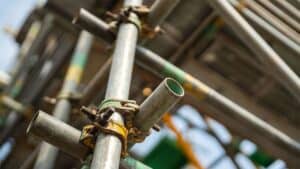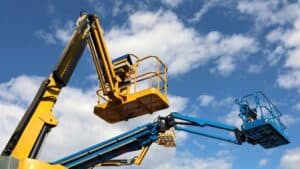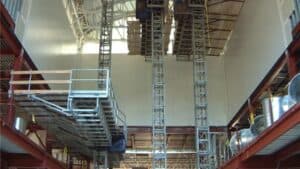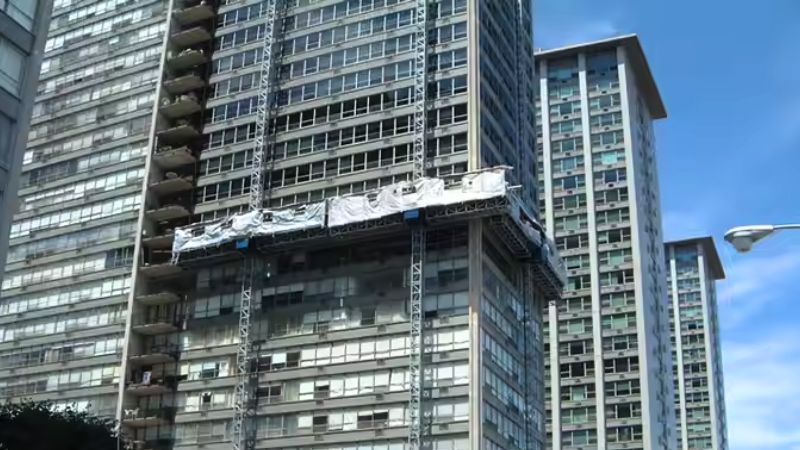
Mast climbers are specialized work platforms that move vertically along one or more masts to provide access to building facades.
These systems combine safety, efficiency, and versatility for various construction and maintenance projects.
Types of Mast Climbers
- Single-Mast Climbers
- Twin-Mast Climbers
- Free-standing Climbers.
- Anchored Climbers
Components of Mast Climbers
- Base Unit: The foundation of the system that distributes the weight and provides stability. It needs to be installed on level, solid ground to ensure safety.
- Mast Sections: Modular vertical components that can be added or removed to adjust the height.
- Platform: The actual work area where crews and materials are positioned.
- Drive System: Usually electric motors that power the climbing mechanism. These motors engage with the mast to move the platform up and down smoothly.
- Control Panel: Allows operators to precisely position the platform at the desired height.
- Anchoring System: Ties the mast to the building structure for stability when operating at greater heights.
Safety Regulations and Standards
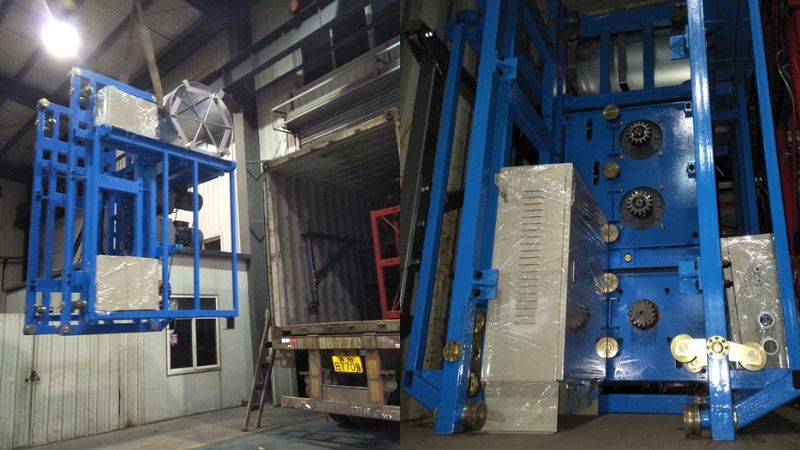
OSHA Compliance
OSHA classifies mast climbers as scaffolds under 29 CFR 1926.450(b). While there aren’t specific OSHA provisions addressing mast climbers directly, they must follow general scaffold safety requirements.
Your mast climber installation must include proper fall protection systems. OSHA requires guardrails on all open sides of platform.
Manufacturer’s Guidelines
Always follow the manufacturer’s specific installation instructions. These guidelines are typically more detailed than general regulations.
The manufacturer will provide maximum load capacities that must never be exceeded. This includes both personnel and materials during installation and use.
Most manufacturers require specific anchor types and spacing. Deviating from these specifications can void warranties and create dangerous conditions.
Installation Process
Disclaimer: This installation guide ligns with EN 1495:2017 (mast climber standards) and OSHA guidelines. Final installation parameters must be approved by the equipment manufacturer and a licensed structural engineer.
Buy Ihurmo’s products means:
• Detailed installation instructions
• Step-by-step tutorial videos
• End-to-end technical support from certified engineers
Our engineering team guarantees seamless implementation, from initial setup to final safety certification
Base Assembly & Anchorin
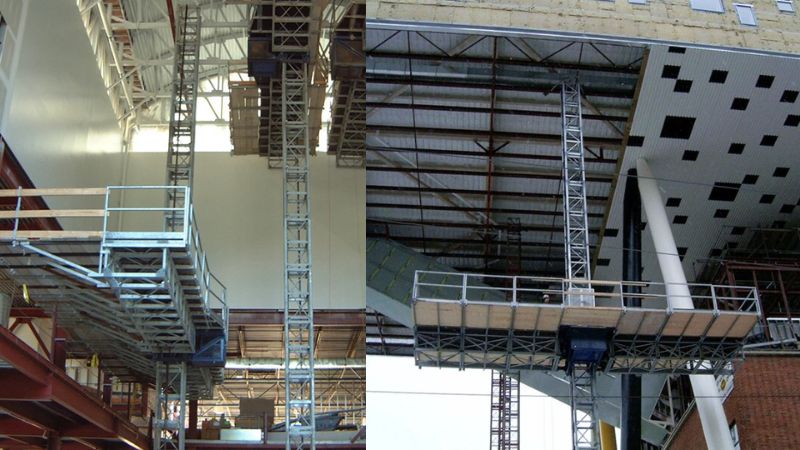
Site Preparation
- Prepare a level, stable surface with load-bearing capacity ≥ mast climber specifications (this should be verified via structural engineer).
- Ground pressure must not exceed manufacturer limits (refer to Ihurmo load diagrams if you already have a Ihurmo mast climber).
Single Mast Base Setup
- Position base frame parallel to the building structure.
- Deploy outriggers to positions specified in Ihurmo load diagrams.
- Use jacks to level the base; ensure wheels are fully disengaged.
- Assemble platform components symmetrically from the drive unit outward:
- Torque platform bolts to 200 Nm.
- Install steps, guardrails, and self-closing gate with safety switch (confirm roller engagement).
Anchoring Protocol
- Drill anchor holes to exact depth per manual specifications; clean debris before insertion.
- Vertical anchors:
- First anchor at 15 m for chassis or 3 m for ground frames.
- Subsequent anchors every 6 m vertically.
- Horizontal anchors: Use wall plates with torque couplings tightened to 50 Nm.
- Verify base level with a spirit level (±0° tolerance).
Mast Section Assembly
Pre-Installation Checks
- Inspect mast sections for damage (dents, cracks, or corrosion).
Installation Sequence
- Attach mast sections sequentially using a crane:
- Align connection points precisely.
- Secure each section with 4× M20 bolts (torque to 200 Nm).
- Install wall ties every 6 m to connect mast to building structure.
- Verify vertical alignment (±2° plumb tolerance) after each section.
Height Restrictions
- Maximum mast height above last anchor: 8 m.
Work Platform Installation
Assembly Guidelines
- Connect platform sections per Ihurmo sequence (ensure alignment).
- Secure guardrails, toe boards, and self-closing gates on all open sides.
Safety Compliance
- Non-slip surface across entire platform.
- Prohibit personnel beneath the platform during movement.
Electrical & Mechanical Systems
Power Requirements
- Supply voltage: confirm via equipment manual
Control System Setup
- Test phase rotation: Control panel must display “00” for correct sequence.
- Program height restrictions/floor stops as needed.
- Verify proximity switches and auto-level system (twin masts).
Pre-Operational Tests
- Emergency stop functionality.
- Brake test: Manual release must NOT cause unintended descent.
- Limit switches at min/max heights.
- Overload protection calibration.
Safety Protocols
- Fall protection required for assembly above 2 m.
- Gates must remain closed during operation (safety switch engaged).
Critical Pitfalls to Avoid
| Issue | Consequence | Mitigation |
|---|---|---|
| Inadequate ground prep | Structural failure | Use load-distribution pads |
| Mast misalignment | Binding/instability | Verify plumb after each anchor |
| Platform overextension | Collapse risk | Limit extensions to 1 m with cross-stripped planks |
Final Commissioning
- Conduct light-load operational test before full deployment.
- All inspections must be signed off by a certified engineer.
Frequently Asked Questions
How can I determine the maximum height for a mast climbing work platform?
The maximum height for your mast climbing work platform depends on the manufacturer’s specifications. For more information, you can visit our website.
What are the essential safety protocols to follow when operating mast climbers?
Always inspect all components before each use. Look for damaged parts, loose connections, or signs of wear that could compromise safety.
Make sure all operators have proper training and certification. Never exceed the manufacturer’s specified load capacity or platform size limits.
Weather monitoring is another need to be consider. Stop operations during high winds, storms, or extreme temperatures that could affect stability or safety.
Can you explain how mast climbers differ from traditional scaffolding systems?
Mast climbers are much faster to install.
They provide better load capacity, typically handling 1,000-4,200 kg compared to conventional scaffolding’s lower weight limits.
Mast climbers offer greater mobility with powered lifting systems. You can adjust working heights precisely with the push of a button instead of climbing up and down.
They also create a more open workspace without cross bracing to navigate around, improving productivity and reducing physical strain.
Are there specific risk assessment procedures for mast climbing work platforms?
Begin by identifying potential hazards like power lines, ground conditions, and weather exposure in your work area.
Assess risks related to loading, including material storage on platforms and weight distribution concerns.
Create emergency evacuation plans specific to different heights and scenarios. Train all workers on these procedures.
Don’t forget perform daily pre-operation inspections using a checklist.

